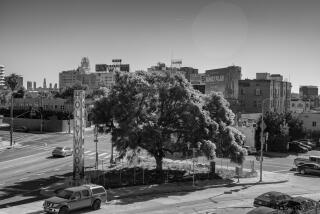On a pilgrimage to the Ancient Bristlecone Pine Forest

The White Mountains that straddle the California-Nevada border are known for their extreme environment. They get less than a foot of rain a year. The wind blows almost constantly, and the temperatures can dip to well below zero.
Hard to imagine, then, that they’re home to the oldest living things on the planet — the ancient warped and twisted bristlecone pine tree, a big draw for photographers, painters and other artists.
“Whether old or young, sheltered or exposed to the wildest gales, these trees are irrepressibly and extravagantly picturesque,” John Muir wrote, “offering a richer and more varied series of forms to the artist than any other species I have yet seen.”
After spending some time recently in the Ancient Bristlecone Pine Forest, I can attest that it’s hard to argue with that.
The area’s winds, often clocking 100 mph or more, play a major role in shaping these trees, and every one looks different from its neighbor. Some are twisted into a corkscrew. Others have branches that stretch in multiple directions.
Perhaps most remarkable is the color of the exposed wood, which glows with shades of orange and gold. The colors are so remarkable that people who have not visited the Ancient Bristlecone Pine Forest often think that images of the old trees have been enhanced or otherwise adjusted to add the intense color. Doing so would be a classic case of gilding a lily. The trees don’t need any human help.
Some of these trees are nearly 5,000 years old and still growing. Some of their dead companion trees still sit in silent testimony to the passing of 10,000 years or more. The living trees were growing when Ptolemy ruled Egypt, when Babylon was a powerful nation and when Alexander the Great was conquering much of the known world.
A walk among them can take on the aura of a pilgrimage.
As you drive up the well-marked road heading northeast from the small town of Big Pine, the snowcapped summits of the Sierra are a vision in the rear-view mirror. A lookout point at Sierra View provides a sweeping panorama of the Sierra and the Palisades glaciers. Nearby is the well-maintained Grandview Campground, a popular camping destination during the summer, even though it and the Bristlecone Pine Forest lack drinking water. (Be sure to pack enough for your stay.)
The paved road ends at Schulman Grove, named for a University of Arizona scientist who discovered the Methuselah Tree, now more than 4,781 years old. Edmund Schulman arrived in the White Mountains in 1953 to study the chronology of tree ring growth from which scientists can determine a tree’s age.
The first humans, members of what was to become known as the Paiute tribe of Native Americans, wandered into this desolate area about 4,000 years ago. They came in summer to gather pine nuts and hunt deer, and they returned with stories about strangely shaped trees whose wood could be used to build a shelter but could not be burned.
Later, gold prospectors and military adventurers encountered these starkly weathered trees. Today, visitors come from around the world to visit these brooding survivors of the centuries.
Not only do these ancient trees tell scientists about weather and growth conditions during their long life but they also offer some insight into the future. The ring patterns show climate changes, and some experts think they may predict the arrival of more such changes on the planet.
Bristlecone Pine Forest manager John Louth said signs of climate change are clear: Warmer temperatures cause more trees to sprout above 10,000 feet. “Patriarch Grove looks like a nursery for bristlecones,” he said of the stand that’s about 12 miles beyond Schulman Grove. “A lot of new shoots are springing up. At the same time, lower bristlecones are being impacted by the encroachment of pinion pine and juniper trees moving up as conditions warm. And they bring pests and diseases with them.”
Several miles and 2,500 feet higher in elevation is the Barcroft White Mountain Research Station, operated by the University of California, where studies of the effects of high altitude on physiology are conducted along with a range of other projects.
“The White Mountains are a great place to study climate change because we have records going back over 60 years and can measure the changes,” said John Smiley, site director for the research station.
The area also boasts one of the largest herds of desert bighorn sheep in California, numbering between 200 and 400.
In most years, the road into the forest is open June 1 to Oct. 31. Snow closes it the rest of the time. This year the snow lingered longer, and the dirt road that takes visitors into Patriarch Grove and other places still had large snowdrifts in mid-June.
Plan on spending a full day walking among these old trees. The longer you stay, the more powerful the sense of their antiquity.
“I get a spiritual sense of the antiquity of the trees,” Louth said. “That’s especially true if you spend some time wandering through the groves. It is a spiritual place.”
To that I would add “amen.”
More to Read
Sign up for The Wild
We’ll help you find the best places to hike, bike and run, as well as the perfect silent spots for meditation and yoga.
You may occasionally receive promotional content from the Los Angeles Times.






